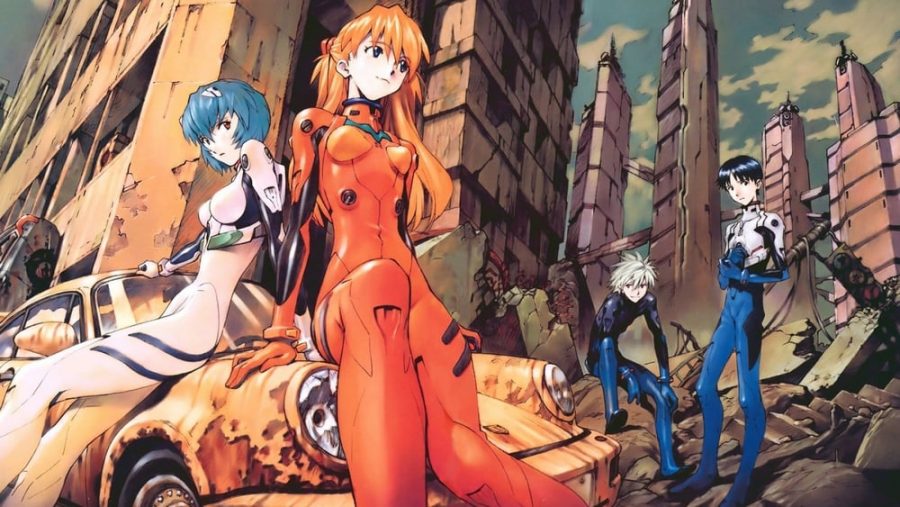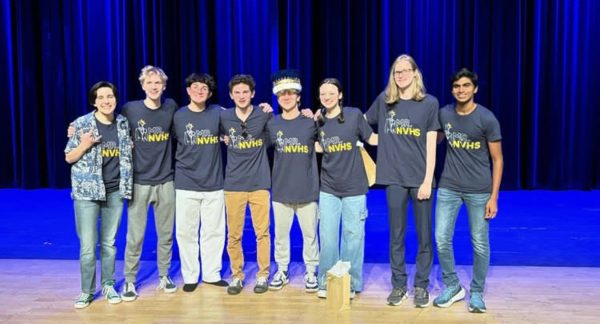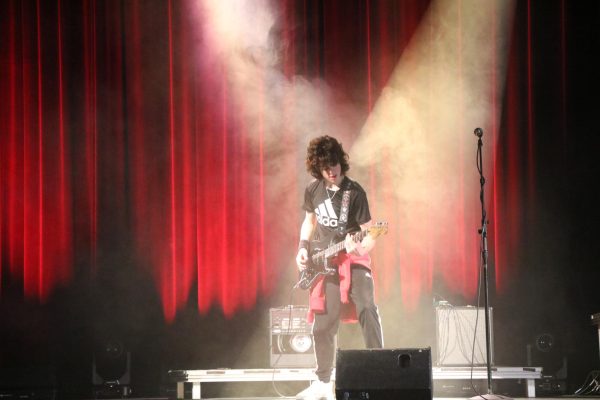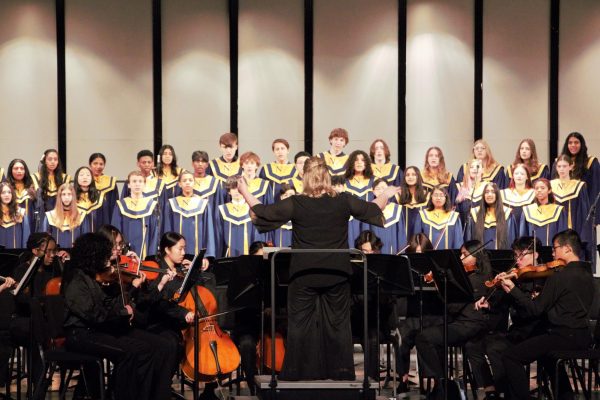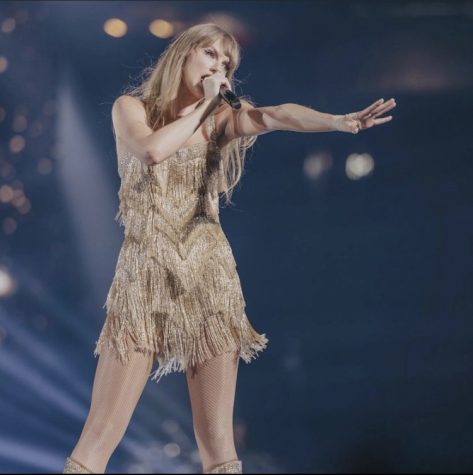“Neon Genesis Evangelion”: the greatest anime across 26 years and three endings
From left to right: Rei Ayanami, Asuka Langley-Soryu, Kaworu Nagisa and Shinji Ikari, the main characters of “Evangelion.”
September 27, 2021
Warning: this article contains major spoilers for “Neon Genesis Evangelion,” “The End of Evangelion” and the “Rebuild of Evangelion” tetralogy.
There are a lot of reasons why I’ve come to appreciate art over the course of my life—the limitless possibilities artists have when it comes to telling a story, the painstaking efforts that so many people pour their blood, sweat and tears into, etc.—but I love filmmaking the most simply because it can do things that I can’t. It can show me creative ideas that couldn’t exist in my reality like Jedis with lightsabers using the Force in another galaxy and it can tell me the real experiences of people on the other side of the world. But the best pieces of art are ones that speak to me on a personal level, regardless of if they’re fantastical, and I don’t think any movie or show—maybe even anything—has ever been more important to me than Hideaki Anno’s masterpiece “Neon Genesis Evangelion.”
“Evangelion” takes place in the then-distant future of 2015. In 2000, a cataclysmic event—supposedly caused by a meteor—dubbed the “Second Impact” wiped out half of the human population, melted the Antarctic ice caps and shifted the earth’s axis. Now, alien creatures called Angels are attacking the earth, and humanity is on the verge of extinction. Their fate has been placed into the hands of Shinji Ikari, a fourteen year old boy who has been ordered by his estranged father Gendo with piloting Eva Unit 01, a massive humanoid robot capable of destroying the Angels. Shinji moves in with Major Misato Katsuragi, who works with his father at the organization NERV, and is joined by two other Eva pilots of the same age, Rei Ayanami and Asuka Langley-Soryu. He now has to take on the Angels, but the Eva pilots’ internal demons and the true intentions of SEELE, the shadowy organization running NERV, will determine the course of mankind.
My First Experience With “Evangelion”
When I first watched “Evangelion,” I went into it with little to no knowledge of what I was getting into. The only things that drew me to it were its revered status and my naive assumption that it was just a fun show about big robots fighting aliens; what teenage boy wouldn’t be interested in that? But then I got to the third episode, and this was when I first realized that “Evangelion” was a lot more than I had made it out to be.
In this episode, we’re introduced to the classmates at Shinji’s new school, Kensuke Aida and Toji Suzuhara, who resents Shinji since his little sister was injured as a result of his fight against an Angel in the previous episode—already a rather bitter note to start on. Eventually, another Angel appears, and the fight starts out in a normal manner. Toji and Kensuke, who sneak out of their emergency shelter to get a glimpse of the action, narrowly avoid being caught in the combat when Shinji lets them in the cockpit of Unit 01, but another issue arises when its power cable gets severed. Shinji now has five minutes to finish off the Angel, and, against Misato’s orders to retreat, attacks it. But instead of him pulling off a calculated execution, he goes berserk and savagely kills it just before Unit 01’s power runs out. The fight sends Shinji into a state of anguish, and Toji ends up forgiving him after seeing how much stress he endures as an Eva pilot.
I vividly remember this moment shaking me. Obviously hearing voice actress Megumi Ogata’s iconic, bone-chilling scream for the first time had a lot to do with that, but it also dawned on me that not everything would have a neat, happy conclusion. Sure, the Angel was killed, Shinji saved the day, but at what cost?
As I got further into “Evangelion,” this feeling exponentially grew as it dove deeper into its characters’ minds. Asuka sinks into clinical, catatonic depression as she loses her ability to pilot Unit 02 and we learn of the traumatic past that shaped her. During a fight with an Angel, Rei absorbs it and Unit 00 explodes and yet she somehow survives; it’s revealed that there are dozens of clones of her that can each hold her soul, although transferring it destroys a chunk of it each time. Toji is chosen as the fourth Eva pilot, but when his Unit 03 gets possessed by an Angel, he quickly defeats Rei and Asuka in combat. Shinji can’t bring himself to destroy Unit 03 at his father’s orders, knowing that there’s a human inside of it, so Gendo overrides Shinji’s control and forces Unit 01 to tear it to shreds, mortally wounding Toji and traumatizing Shinji. He later finds a fleeting love in Asuka’s replacement pilot Kaworu, but Kaworu’s revealed to be an Angel and realizes that Shinji must kill him if humanity is to survive, which he reluctantly does, sending him to his lowest point. Secrets about NERV start to leak out, exposing that the Eva units are clones of Angels that they’ve mechanically restrained, the Eva units piloted by Shinji and Asuka both contain the souls of their dead mothers and the Second Impact wasn’t caused by a meteor but by an expedition led by Misato’s father that did experiments on the first Angel, Adam, who Misato was the sole survivor of.
It continually drove into a rather disheartening direction, and as if I wasn’t already perturbed by the aforementioned events, the final two episodes threw me for a loop. The first ending of “Evangelion” sees SEELE’s true goal come to fruition: the Human Instrumentality Project, where by triggering the Third Impact, all of humanity’s souls will merge into one being in order to end all conflict on earth. Instead of depicting this as an apocalyptic event, the finale completely discards everything that leads up to it and takes place entirely inside the minds of Shinji, Asuka, Rei and Misato. They’re all inquired by an omniscient voice that takes the form of intertitles about their lives, and Shinji witnesses an alternate reality where Evangelions don’t exist. In this world, Asuka is his oldest childhood friend, Rei is a new transfer student and Misato is their teacher. He realizes that he can be more than an Eva pilot and that he can endure the pains of life if it means that he’ll have people who care about him by his side, and the dark void shatters to reveal all of the characters applauding and congratulating him.
That first viewing of “Evangelion” is an experience I hold dearly in my heart. When the screen cut to black, I expected to feel confused and angry, but I knew in the back of my mind that I had watched something that had changed me. After all of the disturbing, perplexing imagery and the confounding narrative and psychological ideas, I was left with an ending that rang hopeful even after the world had seemingly ended. I couldn’t put what I’d witnessed into words, but that didn’t matter, and it clearly was the same way for Hideaki Anno, the creator of the show. Most of “Evangelion” and its characters’ arcs reflect Anno’s own battles with depression, so one could only imagine how cathartic making the ending must have been for him. But for the fans of the series, it couldn’t have been more of a betrayal.
Although it has been re-evaluated over time, the initial reaction to the experimental ending was so harsh that some fans even sent death threats to Anno. This wasn’t necessarily in his control, though; budgetary issues ran rampant throughout the production of the show, which is evident in the frequent instances where there’s only a few frames of animation throughout a given scene—a scene with Asuka and Rei in an elevator lingers on just one still image for nearly a minute, which has become an infamous meme. In 1997, though, Anno would be given a chance to create his original vision, and this is where the second ending of “Evangelion” comes into play.
“The End of Evangelion”
In my haze after finishing the show, I learned of “The End of Evangelion,” the film that served as an alternate version of episodes 25 and 26. I was eager to see an ending that could potentially clarify certain parts of the initial ending I’d seen, and I started watching it at 11:00 p.m. one night. By the time it was over, I genuinely felt like I was going to vomit.
“The End of Evangelion” is essentially identical to the first ending in that it follows SEELE attempting to carry out Instrumentality, but instead of being trapped in the minds of our characters, we get to see what leads up to it, and it might be the single most disturbing, senses-shattering film I’ve ever seen.
The first half of the film follows SEELE’s relentless assault on NERV as Shinji sinks into inertia, and any and all sense of hope the viewer could have is obliterated. It even seems to tease its audience during the scene where Asuka finally awakens from her comatose state, blaring an inordinately optimistic soundtrack only for her to meet a brutal, grisly demise at the hands of SEELE’s mass produced Eva units minutes later. Misato saves Shinji from the troops but gets hit in the stomach with two bullets, and forces him into the Unit 01 bay elevator by giving him a kiss before dying. Gendo tries to enact the Third Impact with Rei, but she rejects him, merges with an Angel and turns into a colossal figure. All of the characters are approached by visions of Rei before exploding into LCL, the liquid that Eva pilots are submerged in when in their Units. There’s a shot during this sequence that pans across the globe as we hear what I can only assume are the screams of millions of people as they die, and Shinji languidly observes it all from Unit 01.
But even after apathetically witnessing so much death and destruction and enabling the dissolution of every human on earth into a primordial soup and merging into one being, he realizes yet again that the risk of being hurt is worth taking if it means that he’ll be able to have an individual identity and connect with others. He rejects Instrumentality and regains his physical form, and Asuka appears sometime after. They are seemingly the only two beings left alive in the universe, stranded on the shores of an apocalyptic wasteland, and, still as emotionally delicate as ever, he starts to strangle her. Instead of fighting back, she reaches up and caresses his face, and he lets her go and starts to weep. She utters one last phrase—“kimochi warui,” which vaguely translates to “how disgusting”—and with that, “Evangelion” comes to its second end.
“The End of Evangelion” is one of the greatest accomplishments not just in the history of animation and filmmaking but art as a whole. Its experimental second half contains such brilliant, wild editing that it’s borderline impossible for me to imagine any human being behind it; it feels like it was constructed by some otherworldly, all-knowing being. Although it’s never been the main focus of the franchise, the action here is astounding and exemplary; it’s so fluidly staged and pictured, but the physical sensation that the imagery and sound design creates from the blunt impact of each explosion and hit is unparalleled. As sickening and visceral as it is, though, I’ve realized on subsequent viewings that it is indeed a happy ending—it might even be more hopeful than the first in that Shinji not only realizes his own worth but escapes Instrumentality as a whole. It likely won’t seem that way for many people who watch it, but it’s at least bittersweet for me.
And for a decade, that’s what fans were left with—some hailed it as perfect and others panned it as insufficient and incomprehensible, but whether everyone liked it or not, it was all we would get. But in 2007, Anno would release a new project, the “Rebuild of Evangelion.” The Rebuilds would allow him to create “Evangelion” as he intended it to be from the beginning and without any technical or budgetary constraints. While this is most definitely because of the attachment I had to his original product, I always find it a little weird in my own head that this was the path Anno had envisioned, but after having watched all four of the films, I can certainly say that it was worth it.
“Rebuild of Evangelion”
The Rebuilds start with “Evangelion: 1.0 You Are (Not) Alone,” which many saw as a slow start to the new series since it’s little more than a condensed, watered down version of the first six episodes of the show. While its fresh usage of CGI does invigorate the fights with the Angels, it spends too much of its runtime on the splendid action and rushes through a lot of the character development that made the original series what it was. I still enjoyed “1.0,” but when I first watched it, I couldn’t help but wonder where the next film was going to go. “Evangelion: 2.0 You Can (Not) Advance” slowly but surely diverges from the original source material, starting with the introduction of a new Eva pilot, Mari Illustrious Makinami, and eventually forges a new path entirely with its dazzling climax. Shinji, in an attempt to save Rei, ends up merging with Unit 01 and the remains of an Angel, sprouting wings of light and evolving into a godlike being. Misato recognizes the wings as the same ones she witnessed in 2000 during the Second Impact, and realizes that the Third Impact and the end of humanity is upon them. It’s a pretty major escalation of events from “1.0,” but it sticks the landing with grace, mainly because the thrilling action and animation from the previous installment is seamlessly woven into the new narrative beats.
“Evangelion: 3.0 You Can (Not) Advance” is the most interesting work of not just the Rebuilds but, in my opinion, the whole franchise, and it’s easy to see why from the very beginning. “3.0” leaps fourteen years into the future; Unit 01, containing Shinji, is pulled from orbit by Mari and Asuka, who now dons an eyepatch, but instead of a warm welcome, the world he meets is cold and unrecognizable. Misato is now the captain of WILLE, an organization hellbent on destroying NERV, and she fits him with an explosive choker that she holds the detonator for, callously telling him that she’ll kill him if he pilots another Eva after causing the Third Impact. All of the Eva pilots haven’t physically aged despite the years that have passed, which Asuka vaguely explains is “the curse of Eva.” Rei, who was thought to be missing, intercepts WILLE’s ship, the Wunder, rescues Shinji and takes him to the desolate NERV headquarters, where Gendo orders him to pilot a new Eva, Unit 13, alongside Kaworu. The two bond over piano sessions, but Rei doesn’t remember Shinji or the world and seemingly lives just to follow orders, leading him to conclude that she isn’t the person he knew her to be—it’s revealed (again) that she’s nothing more than the latest in a line of clones of Gendo’s dead wife Yui, whose soul resides in Unit 01. Shinji is disturbed by this, but Kaworu gains his trust by removing his choker and putting it on himself and telling him that there’s a way to possibly undo the Third Impact. The two activate Unit 13, to which Asuka and Mari are dispatched to stop by Misato, and an Angel appears from a dormant Eva unit. Kaworu and Asuka both realize that something is going wrong and beg Shinji to stop, only sending him into a further rage. Unit 13 is fully awoken, unleashing another set of arms and beginning the Fourth Impact. Kaworu reveals he is an Angel and activates the choker, sacrificing himself to stop the Fourth Impact and traumatizing Shinji. Mari ejects Shinji from Unit 13, and the film ends with Asuka retrieving him from the entry plug and dragging him along through the barren, cerise wasteland of Tokyo-3 with Rei following behind.
“3.0” is, simply put, annihilative. It’s fully detached from everything that came before it and overwhelmingly obfuscating, but even while it feels like a slap in the face, it might just be the most exemplary piece of “Evangelion”—think if “The End of Evangelion” were stripped of its orotund grandeur and was left to wither, a despondent shell of its legendary predecessors. The only unanimous praise that the film garnered was for its animation, which is some of the best of the century. This is a spellbinding visual achievement, rife with impeccable detail and incomparably haunting imagery. After I finished it, I didn’t quite know what to make of it, but I knew that it was remarkable, peerless filmmaking. This sentiment has been echoed over the years, but at the time of its release, it divided fans like never before. Anno had seemingly abandoned everything that he had built, and there was no way of knowing where the final film would go from here. It was a long wait, but after nine years, the world has been graced with the final—and most important—ending to the franchise: “Evangelion: 3.0+1.0 Thrice Upon a Time.”
Stay tuned for a follow-up piece on “Evangelion: 3.0+1.0 Thrice Upon a Time” and the impact that “Evangelion” has made on pop culture and my life.

